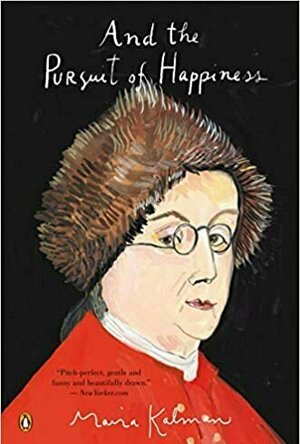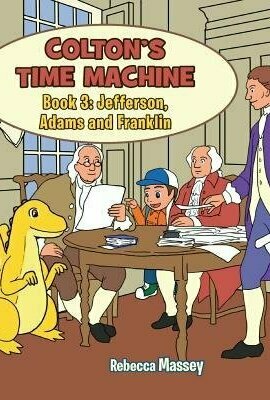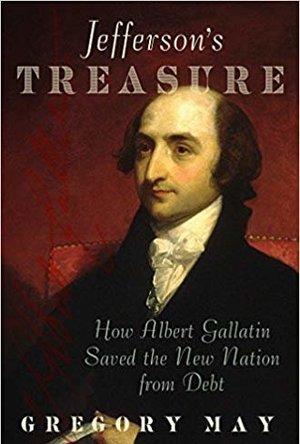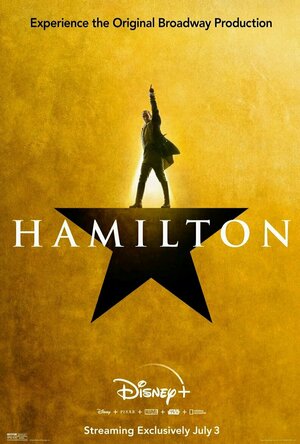Search
Search results
Alice Waters recommended And the Pursuit of Happiness in Books (curated)
Lindsay (1779 KP) rated Colton's Time Machine: Jefferson, Adams, Franklin (Book #3) in Books
Aug 28, 2021
Are you a history fan? Do you want a fun and enjoyable way to teach history lessons to your children or even your students? Well, Colton's Time Machine will help you with this. I have read and checked out "Colton's Time Machine: Jefferson, Adams, and Franklin" by Rebecca Massey.
Colton and his friends go on adventures to meet three historical figures. Each one is detailed and done well. Children will learn a bit of history about Thomas Jefferson, John Adam, and Benjamin Franklin. The way Colton deals with some of the antics the dragons do. It is enjoyable and teachable to any child or children. Children will be smiling and learning history lessons through the book; Not all but some American critical historical events.
Each chapter is separated for each prominent historical figure. The pictures are bright and fun to look at. It seems like Colton is teaching some dragons about sharing and asking to use things. There seem to be some life lessons through the book as well as some history.
Teachers and parents alike will want to add this series to their classroom or even their child or children's bookshelves. This series is a spin-off to Colton's Pocket Dragons. Suitable for children to learn about American history and the importance of democracy.
Colton and his friends go on adventures to meet three historical figures. Each one is detailed and done well. Children will learn a bit of history about Thomas Jefferson, John Adam, and Benjamin Franklin. The way Colton deals with some of the antics the dragons do. It is enjoyable and teachable to any child or children. Children will be smiling and learning history lessons through the book; Not all but some American critical historical events.
Each chapter is separated for each prominent historical figure. The pictures are bright and fun to look at. It seems like Colton is teaching some dragons about sharing and asking to use things. There seem to be some life lessons through the book as well as some history.
Teachers and parents alike will want to add this series to their classroom or even their child or children's bookshelves. This series is a spin-off to Colton's Pocket Dragons. Suitable for children to learn about American history and the importance of democracy.
Sassy Brit (97 KP) rated Jefferson's Treasure: How Albert Gallatin Saved the New Nation from Debt in Books
Jun 5, 2019
Jefferson’s Treasure, by Gregory May, details, “how Albert Gallatin saved the new nation from debt.” Appointed by President Thomas Jefferson to be his Treasury Secretary, Gallatin continued under President Madison, maintaining that position for twelve years. During his tenure, he abolished internal revenue taxes in peacetime, slashed federal spending, and repaid half of the national debt.
So who was this man that undid Alexander Hamilton’s fiscal system, rejecting it along with Madison and Jefferson? Because both Presidents did not understand the financial system, they depended on Gallatin to reform it. Gallatin arrived in America in 1790 from Geneva and rose up to become a trusted advisor of the Republicans. Six years before Jefferson was elected President, Gallatin’s Pennsylvania neighbors rebelled against the tax on whiskey. He supported them in principle but opposed the violence that ensued, burning the local tax collector’s house, robbing the mail, and marching on Pittsburgh.
The play “Hamilton” uses revisionist history. The real Hamilton believed in big government and wanted to continue funding federal deficits. He based his theories on the British who used the money to fund their large military conflicts, believing that the ability to borrow endless amounts of money would allow the new United States to become a great nation. Jefferson and Madison thought Hamilton’s system, straight from the British way, was tainted with tyranny. As May noted, “It made the people pay obnoxious taxes in order to fund interest payments on a mounting federal debt and the costs of an expensive military establishment. It shifted money from ordinary taxpayers to the relatively few rich men who held the government’s bonds. That was just the sort of thing that had led Americans to revolt against Britain in the first place.”
May believes, “The hip-hop immigrant hero of the Broadway musical is a myth. The musical might be a great work of art, but is relies on misconceptions of Hamilton. He was not an immigrant, but a migrant within the British Empire. Also, he was not a man of the people, as Gallatin was, but an elitist.”
While Hamilton committed to paying only the interest on the government’s debt, Gallatin committed the government to repaying fixed amounts of the principal each year. He also insisted that the government should never spend more than it earned except in times of war. By slashing federal expenses, Gallatin was able to get rid of the tax on whiskey and abolish the entire internal revenue service.
The Republicans, an agrarian society, distrusted these elitists where two-thirds of the government debt belonged to a few hundred very wealthy men residing mainly in Philadelphia, New York, and other mercantile cities. They saw Hamilton’s plan of collecting taxes from ordinary citizens as a way for a few rich men to become even wealthier. Implementing these excise taxes required government officials to inspect, quantify, and mark the items subject to tax.
The Hamilton system benefited the wealthy debt holders and spectators at the expense of the average taxpayer who had to pay the interest. The government would borrow more than the people could pay. Hamilton tried to hide how much money the government was actually spending and spiraled the debt higher and higher.
This was an important part of the British tax base, and “I wanted to show how unpopular it was. Hamilton and company were resented because they created a tax collection network that affected the lives of ordinary citizens. The excise tax is a form of internal taxation, while tariffs are a form of external taxation that fell on the well to do. Remember mostly the well to do bought imports. The Republicans once they came to power relied on import duties rather than excise taxes.”
May further explained, “When Jefferson and his administration came to power it was Gallatin who got rid of Hamilton’s deficit finance system and cut taxes. By the time he has left office he has repaid half the federal debt and set up a program for repaying the rest.”
Anyone who wants to understand the early economic systems of the Founding Fathers will enjoy this book. It shows how Gallatin, by killing Hamilton’s financial system, abolished internal revenue taxes in peacetime, slashed federal spending, and repaid half of the national debt.
So who was this man that undid Alexander Hamilton’s fiscal system, rejecting it along with Madison and Jefferson? Because both Presidents did not understand the financial system, they depended on Gallatin to reform it. Gallatin arrived in America in 1790 from Geneva and rose up to become a trusted advisor of the Republicans. Six years before Jefferson was elected President, Gallatin’s Pennsylvania neighbors rebelled against the tax on whiskey. He supported them in principle but opposed the violence that ensued, burning the local tax collector’s house, robbing the mail, and marching on Pittsburgh.
The play “Hamilton” uses revisionist history. The real Hamilton believed in big government and wanted to continue funding federal deficits. He based his theories on the British who used the money to fund their large military conflicts, believing that the ability to borrow endless amounts of money would allow the new United States to become a great nation. Jefferson and Madison thought Hamilton’s system, straight from the British way, was tainted with tyranny. As May noted, “It made the people pay obnoxious taxes in order to fund interest payments on a mounting federal debt and the costs of an expensive military establishment. It shifted money from ordinary taxpayers to the relatively few rich men who held the government’s bonds. That was just the sort of thing that had led Americans to revolt against Britain in the first place.”
May believes, “The hip-hop immigrant hero of the Broadway musical is a myth. The musical might be a great work of art, but is relies on misconceptions of Hamilton. He was not an immigrant, but a migrant within the British Empire. Also, he was not a man of the people, as Gallatin was, but an elitist.”
While Hamilton committed to paying only the interest on the government’s debt, Gallatin committed the government to repaying fixed amounts of the principal each year. He also insisted that the government should never spend more than it earned except in times of war. By slashing federal expenses, Gallatin was able to get rid of the tax on whiskey and abolish the entire internal revenue service.
The Republicans, an agrarian society, distrusted these elitists where two-thirds of the government debt belonged to a few hundred very wealthy men residing mainly in Philadelphia, New York, and other mercantile cities. They saw Hamilton’s plan of collecting taxes from ordinary citizens as a way for a few rich men to become even wealthier. Implementing these excise taxes required government officials to inspect, quantify, and mark the items subject to tax.
The Hamilton system benefited the wealthy debt holders and spectators at the expense of the average taxpayer who had to pay the interest. The government would borrow more than the people could pay. Hamilton tried to hide how much money the government was actually spending and spiraled the debt higher and higher.
This was an important part of the British tax base, and “I wanted to show how unpopular it was. Hamilton and company were resented because they created a tax collection network that affected the lives of ordinary citizens. The excise tax is a form of internal taxation, while tariffs are a form of external taxation that fell on the well to do. Remember mostly the well to do bought imports. The Republicans once they came to power relied on import duties rather than excise taxes.”
May further explained, “When Jefferson and his administration came to power it was Gallatin who got rid of Hamilton’s deficit finance system and cut taxes. By the time he has left office he has repaid half the federal debt and set up a program for repaying the rest.”
Anyone who wants to understand the early economic systems of the Founding Fathers will enjoy this book. It shows how Gallatin, by killing Hamilton’s financial system, abolished internal revenue taxes in peacetime, slashed federal spending, and repaid half of the national debt.
BankofMarquis (1832 KP) rated Hamilton (2020) in Movies
Jul 5, 2020
Captures the power of being in "the room where it happens"
I'll just cut to the chase, the filmed version of the mega-hit stage musical HAMILTON (now streaming on Disney+) is terrific. If you are one of the few that have not seen this, check it out - you'll be glad you did.
I could go on and on about the Pulitzer-Prize winning show, the script, the music, the performances and/or the cross-cultural casting - all of which works to perfection, but what separates this film from the other hit Broadway shows that are converted to film is how well that the filmmakers were able to translate the power of being inside the theater during a live performance of this show.
Credit, of course, needs to go to the visionaries responsible for this show, creator/writer/star Lin-Manuel Miranda and Director Thomas Kail. They realized pretty early on (when the show was becoming the phenomenon that it has become) that they wanted to preserve this event for future generations, so started making plans to film the show - in High Def - with an audience and without an audience (for close-ups). In June 2016, about a month before the original cast started leaving the show (and right after the show won 11 Tony Awards), they spent $10 million to capture the show - with live audiences on Sunday and Tuesday and then spent the rest of Sunday night and all day Monday doing close-ups and crane shots to augment the action.
The results are outstanding. The wide-shots show the breadth of the production - showing the strong, Tony Award winning choreography by Andy Blankenbuehler, the unique, minimal and highly versatile set, the Tony Award winning costumes by Paul Tazewell and the Lighting Design that earned Howell Blinkley a Tony. All of these are showcased in this film - special note should be made about the Lighting that needed to be tweaked on the spot for the filming.
As for the close-ups, they showcase the wry smile and comedic delight that Tony winner Daveed Diggs shows in his roles as Lafayette/Jefferson, the power and sorrow of Tony Award winner Renee Elise Goldsberry - her spotlight number SATISFIED is as "perfect" a musical number as you will ever see. The powerful acting of Leslie Odom, Jr. as Aaron Burr (who won the Tony as Best Actor over Lin-Manuel's performance as Hamilton) as well as terrific supporting turns by the likes of Anthony Ramos (Lawrence/Phillip), Chris Jackson (showing real leadership as George Washington) and Okieriete Onaodwoan as Hercules Mulligan (one of my absolute favorite characters in this show)./James Madison.
Special note should be made to Jonathan Groff's portrayal of King George III - it is, basically, a cameo role, but he is filmed with such tight close-ups (showing spittle rolling down has chin as he sings) that marvelously juxtaposes King George's real emotions with that of the words he is speaking.
But, of course, the real star is Lin-Manuel Miranda - the genius creative force behind Hamilton. Interestingly enough, I thought his performance was the weakest of the lead cast (don't get me wrong, he was still excellent - just not "as excellent" as some of the others). His true vision, of course, was to tell the story of "the people of that era" as told by "the people of our era".
That is the true genius of Hamilton.
Letter Grade: A+
10 stars out of 10 (can I turn this up to 11)?
I could go on and on about the Pulitzer-Prize winning show, the script, the music, the performances and/or the cross-cultural casting - all of which works to perfection, but what separates this film from the other hit Broadway shows that are converted to film is how well that the filmmakers were able to translate the power of being inside the theater during a live performance of this show.
Credit, of course, needs to go to the visionaries responsible for this show, creator/writer/star Lin-Manuel Miranda and Director Thomas Kail. They realized pretty early on (when the show was becoming the phenomenon that it has become) that they wanted to preserve this event for future generations, so started making plans to film the show - in High Def - with an audience and without an audience (for close-ups). In June 2016, about a month before the original cast started leaving the show (and right after the show won 11 Tony Awards), they spent $10 million to capture the show - with live audiences on Sunday and Tuesday and then spent the rest of Sunday night and all day Monday doing close-ups and crane shots to augment the action.
The results are outstanding. The wide-shots show the breadth of the production - showing the strong, Tony Award winning choreography by Andy Blankenbuehler, the unique, minimal and highly versatile set, the Tony Award winning costumes by Paul Tazewell and the Lighting Design that earned Howell Blinkley a Tony. All of these are showcased in this film - special note should be made about the Lighting that needed to be tweaked on the spot for the filming.
As for the close-ups, they showcase the wry smile and comedic delight that Tony winner Daveed Diggs shows in his roles as Lafayette/Jefferson, the power and sorrow of Tony Award winner Renee Elise Goldsberry - her spotlight number SATISFIED is as "perfect" a musical number as you will ever see. The powerful acting of Leslie Odom, Jr. as Aaron Burr (who won the Tony as Best Actor over Lin-Manuel's performance as Hamilton) as well as terrific supporting turns by the likes of Anthony Ramos (Lawrence/Phillip), Chris Jackson (showing real leadership as George Washington) and Okieriete Onaodwoan as Hercules Mulligan (one of my absolute favorite characters in this show)./James Madison.
Special note should be made to Jonathan Groff's portrayal of King George III - it is, basically, a cameo role, but he is filmed with such tight close-ups (showing spittle rolling down has chin as he sings) that marvelously juxtaposes King George's real emotions with that of the words he is speaking.
But, of course, the real star is Lin-Manuel Miranda - the genius creative force behind Hamilton. Interestingly enough, I thought his performance was the weakest of the lead cast (don't get me wrong, he was still excellent - just not "as excellent" as some of the others). His true vision, of course, was to tell the story of "the people of that era" as told by "the people of our era".
That is the true genius of Hamilton.
Letter Grade: A+
10 stars out of 10 (can I turn this up to 11)?



